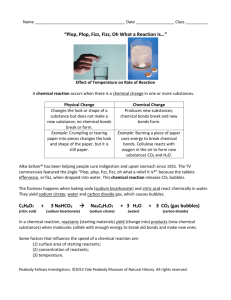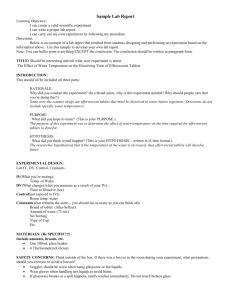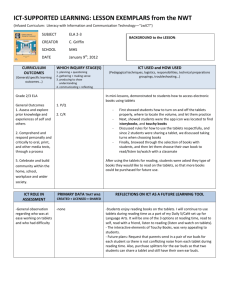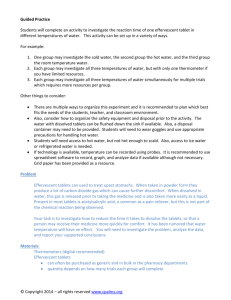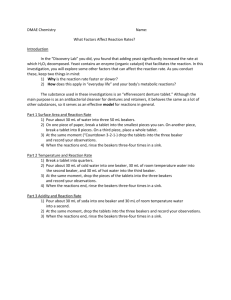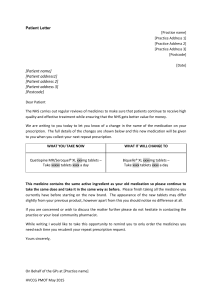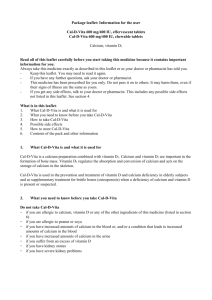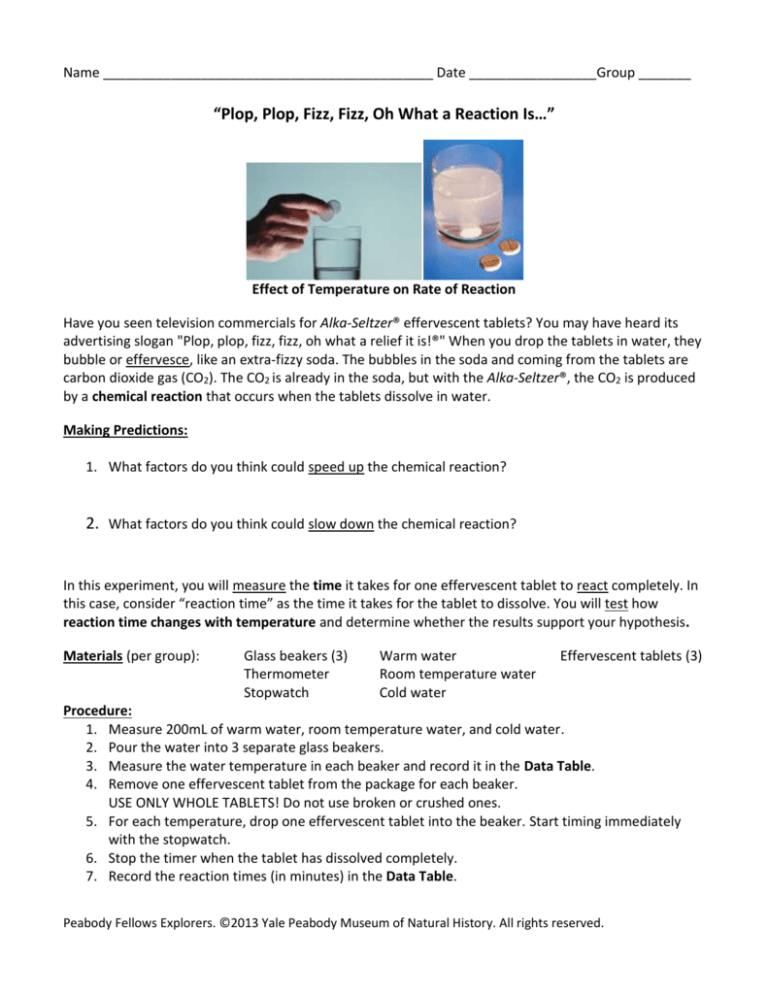
Name ____________________________________________ Date _________________Group _______
“Plop, Plop, Fizz, Fizz, Oh What a Reaction Is…”
Effect of Temperature on Rate of Reaction
Have you seen television commercials for Alka-Seltzer® effervescent tablets? You may have heard its
advertising slogan "Plop, plop, fizz, fizz, oh what a relief it is!®" When you drop the tablets in water, they
bubble or effervesce, like an extra-fizzy soda. The bubbles in the soda and coming from the tablets are
carbon dioxide gas (CO2). The CO2 is already in the soda, but with the Alka-Seltzer®, the CO2 is produced
by a chemical reaction that occurs when the tablets dissolve in water.
Making Predictions:
1. What factors do you think could speed up the chemical reaction?
2. What factors do you think could slow down the chemical reaction?
In this experiment, you will measure the time it takes for one effervescent tablet to react completely. In
this case, consider “reaction time” as the time it takes for the tablet to dissolve. You will test how
reaction time changes with temperature and determine whether the results support your hypothesis.
Materials (per group):
Glass beakers (3)
Thermometer
Stopwatch
Warm water
Room temperature water
Cold water
Effervescent tablets (3)
Procedure:
1. Measure 200mL of warm water, room temperature water, and cold water.
2. Pour the water into 3 separate glass beakers.
3. Measure the water temperature in each beaker and record it in the Data Table.
4. Remove one effervescent tablet from the package for each beaker.
USE ONLY WHOLE TABLETS! Do not use broken or crushed ones.
5. For each temperature, drop one effervescent tablet into the beaker. Start timing immediately
with the stopwatch.
6. Stop the timer when the tablet has dissolved completely.
7. Record the reaction times (in minutes) in the Data Table.
Peabody Fellows Explorers. ©2013 Yale Peabody Museum of Natural History. All rights reserved.
Results:
Data Table
Water Type
Temperature (oC)
Reaction Time
(minutes and seconds)
Warm
Room Temperature
Cold
Questions and Conclusions:
1. What is the independent variable?
2. What is the dependent variable?
3. Which variables were constant? (List at least 2.)
4. Why did we use whole tablets for each demonstration? What might happen if we used broken
tablets?
5. What might happen if some students stirred the water as the tablets were dissolving?
6. How can you relate this activity to the life cycle of a mosquito?
Peabody Fellows Explorers. ©2013 Yale Peabody Museum of Natural History. All rights reserved.
Teacher Notes
Hints and Tips for Teachers:
If your students are not familiar with the Alka-Seltzer® commercials, several versions are
available on YouTube.
You can also use generic brand effervescent tablets.
You might like to introduce this activity with a review of physical and chemical changes.
Comparing tearing paper with burning paper is a good example. Sugar also shows a physical
change when dissolved in water, but a chemical change when burned. However, it is both a
physical and chemical change to dissolve salt in water. Even though you can recover salt crystals
by evaporating the water, the Na+ and Cl– ions dissociate when dissolved.
This lab can be done without timing the reaction. For a quick demonstration, drop the tablets
into each of the three water temperature beakers simultaneously and just observe the difference
in reaction times.
Peabody Fellows Explorers. ©2013 Yale Peabody Museum of Natural History. All rights reserved.

